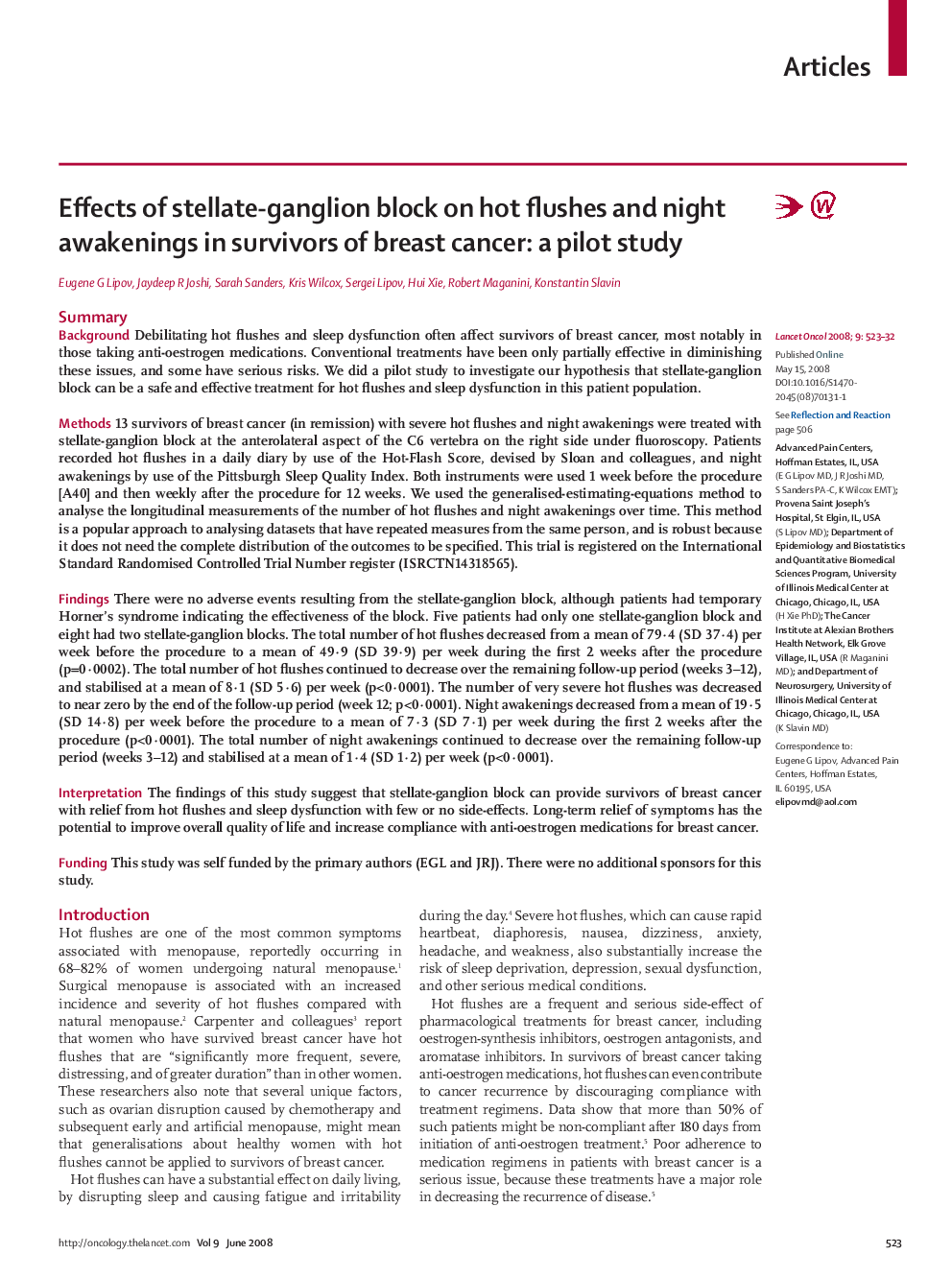| کد مقاله | کد نشریه | سال انتشار | مقاله انگلیسی | نسخه تمام متن |
|---|---|---|---|---|
| 3994841 | 1258917 | 2008 | 10 صفحه PDF | دانلود رایگان |

SummaryBackgroundDebilitating hot flushes and sleep dysfunction often affect survivors of breast cancer, most notably in those taking anti-oestrogen medications. Conventional treatments have been only partially effective in diminishing these issues, and some have serious risks. We did a pilot study to investigate our hypothesis that stellate-ganglion block can be a safe and effective treatment for hot flushes and sleep dysfunction in this patient population.Methods13 survivors of breast cancer (in remission) with severe hot flushes and night awakenings were treated with stellate-ganglion block at the anterolateral aspect of the C6 vertebra on the right side under fluoroscopy. Patients recorded hot flushes in a daily diary by use of the Hot-Flash Score, devised by Sloan and colleagues, and night awakenings by use of the Pittsburgh Sleep Quality Index. Both instruments were used 1 week before the procedure [A40] and then weekly after the procedure for 12 weeks. We used the generalised-estimating-equations method to analyse the longitudinal measurements of the number of hot flushes and night awakenings over time. This method is a popular approach to analysing datasets that have repeated measures from the same person, and is robust because it does not need the complete distribution of the outcomes to be specified. This trial is registered on the International Standard Randomised Controlled Trial Number register (ISRCTN14318565).FindingsThere were no adverse events resulting from the stellate-ganglion block, although patients had temporary Horner's syndrome indicating the effectiveness of the block. Five patients had only one stellate-ganglion block and eight had two stellate-ganglion blocks. The total number of hot flushes decreased from a mean of 79·4 (SD 37·4) per week before the procedure to a mean of 49·9 (SD 39·9) per week during the first 2 weeks after the procedure (p=0·0002). The total number of hot flushes continued to decrease over the remaining follow-up period (weeks 3–12), and stabilised at a mean of 8·1 (SD 5·6) per week (p<0·0001). The number of very severe hot flushes was decreased to near zero by the end of the follow-up period (week 12; p<0·0001). Night awakenings decreased from a mean of 19·5 (SD 14·8) per week before the procedure to a mean of 7·3 (SD 7·1) per week during the first 2 weeks after the procedure (p<0·0001). The total number of night awakenings continued to decrease over the remaining follow-up period (weeks 3–12) and stabilised at a mean of 1·4 (SD 1·2) per week (p<0·0001).InterpretationThe findings of this study suggest that stellate-ganglion block can provide survivors of breast cancer with relief from hot flushes and sleep dysfunction with few or no side-effects. Long-term relief of symptoms has the potential to improve overall quality of life and increase compliance with anti-oestrogen medications for breast cancer.FundingThis study was self funded by the primary authors (EGL and JRJ). There were no additional sponsors for this study.
Journal: - Volume 9, Issue 6, June 2008, Pages 523–532